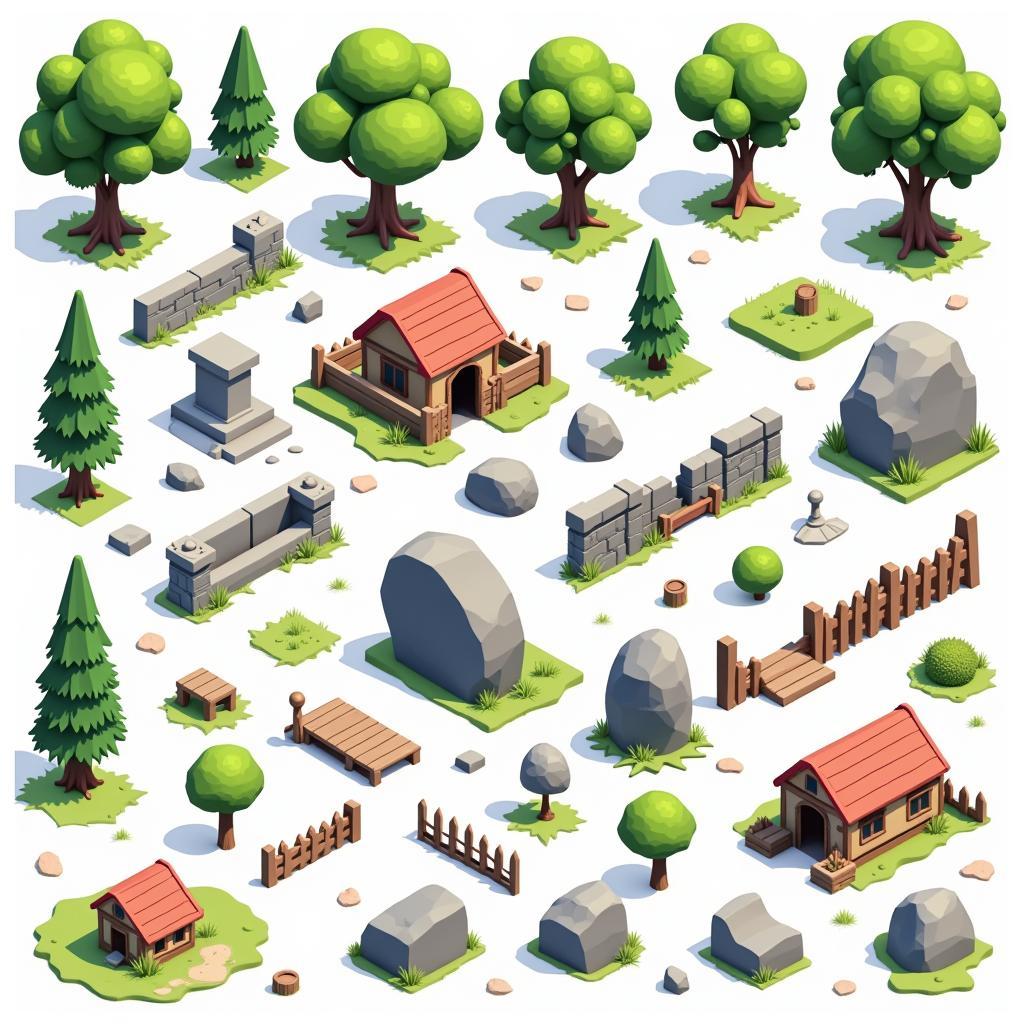Fixed Objects play a crucial role in shaping the world of a video game. But what exactly are they, and why should you, as a gamer, care about them? This guide delves into the concept of fixed objects, exploring their definition, significance, and impact on your gaming experience.
What are Fixed Objects in Gaming?
In the simplest terms, a fixed object in a video game refers to any element within the game environment that remains stationary and unmovable. These objects are an integral part of the game’s level design, contributing to the overall aesthetics, gameplay mechanics, and immersion.
 Examples of Fixed Objects in Video Games
Examples of Fixed Objects in Video Games
Why are Fixed Objects Important?
While they may seem insignificant compared to dynamic elements like characters or moving platforms, fixed objects are far from trivial. Their importance stems from the following factors:
1. World Building and Immersion
Fixed objects are the building blocks of a game’s environment. They define the landscape, create a sense of place, and contribute to the overall atmosphere of the game. Imagine playing a fantasy RPG without towering trees, imposing castles, or dilapidated ruins. The absence of such fixed objects would leave the game world feeling empty and unconvincing.
2. Gameplay Mechanics
Fixed objects often play a direct role in shaping gameplay mechanics. They can act as obstacles, providing challenges for the player to overcome. In a platformer, for instance, fixed objects like walls and ledges dictate the player’s movement and jumping patterns. In other genres, they can provide cover in combat scenarios, create strategic chokepoints, or serve as puzzle elements.
3. Visual Storytelling
Fixed objects can be powerful tools for visual storytelling. A crumbling statue, a bloodstained wall, or even a carefully placed book can convey a wealth of information about the game’s lore, history, and atmosphere without relying on explicit dialogue or cutscenes.
Types of Fixed Objects
Fixed objects encompass a wide range of elements within a game world. Some common types include:
- Natural elements: Trees, rocks, mountains, rivers, and other natural formations.
- Structures: Buildings, walls, fences, bridges, and other man-made constructions.
- Props and Decorations: Furniture, clutter, debris, signs, and other objects that enhance the visual detail and realism of the environment.
The Evolution of Fixed Objects
With advancements in game development technology, fixed objects have evolved significantly. Early video games featured simple, pixelated representations of fixed objects due to technological limitations. However, as technology progressed, developers gained the ability to create more detailed, realistic, and interactive fixed objects.
Today, fixed objects can exhibit a high degree of visual fidelity, with advanced lighting, textures, and physics simulations that enhance their realism and contribute to a more immersive gaming experience. Some games even allow players to interact with fixed objects in more meaningful ways, such as destroying them, moving them, or using them to solve puzzles.
Fixed Objects and Game Design
The strategic placement and design of fixed objects are crucial aspects of game design. Level designers carefully consider the following factors when incorporating fixed objects:
- Player Navigation: Fixed objects can guide the player along intended paths, create natural barriers, and control the pacing of exploration.
- Visual Hierarchy: The size, shape, and placement of fixed objects can draw the player’s eye to important areas or points of interest within the game world.
- Challenge and Difficulty: Fixed objects can be used to create obstacles, puzzles, and combat encounters that test the player’s skills and provide a sense of accomplishment.
Conclusion
While often overlooked, fixed objects are essential components of video games, contributing significantly to the overall gaming experience. They shape the game world, influence gameplay mechanics, and enhance storytelling. As you explore your favorite virtual worlds, take a moment to appreciate the role that fixed objects play in bringing those environments to life.
FAQs about Fixed Objects in Games
1. Can fixed objects be destroyed in games?
The destructibility of fixed objects depends on the specific game’s design. Some games feature destructible environments where players can demolish certain fixed objects, adding an extra layer of interactivity and realism. However, other games may have indestructible fixed objects that serve as permanent fixtures in the game world.
2. How do developers create fixed objects for video games?
Game developers use specialized software like 3D modeling programs and game engines to create fixed objects. They design, texture, and animate these objects before integrating them into the game world.
Need Help?
Contact VNG Game support for assistance:
Phone: 0902476650
Email: [email protected]
Address: 139 Đ. Võ Văn Kiệt, Hoà Long, Bà Rịa, Bà Rịa – Vũng Tàu, Việt Nam.
We’re available 24/7 to help!





